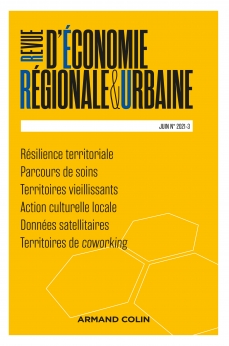
REVUE D'ÉCONOMIE RÉGIONALE ET URBAINE (3/2021)
Pour acheter ce numéro, contactez-nous
Recevez les numéros de l'année en cours et accédez à l'intégralité des articles en ligne.
Les notions de « parcours patient », « parcours de soins », « parcours de santé », « parcours de vie » sont aujourd’hui largement mobilisées et reprises dans les discours et discussions politiques et professionnels autour de l’amélioration de la prise en charge des patients (Porter, 2010). Dans le domaine managérial, la mobilisation de ces notions souffre d’une importante faiblesse conceptuelle. Peu de réflexions empiriques ou scientifiques permettent de définir précisément comment construire le management intégré et global d’un parcours de soins dans et hors les murs des établissements de santé. L’approche de cartographie géographique peut s’avérer très pertinente pour penser un management des parcours territorialisés en représentant conjointement les ressources médicales et soignantes et les populations de patients. L’application de cette approche à l’Auvergne permet de définir trois types de territoires de santé et de repérer des leviers d’action pour un management intégré des parcours de soins.
"Patient pathways", "care pathways", "health pathways" and "life pathways" are now concepts widely used in political and professional discourses and discussions on improving patient care (Porter, 2010). In the managerial sciences, the mobilisation of these notions suffers from an important conceptual weakness. There is very little empirical or scientific research to define precisely how to build an integrated and comprehensive management of a care pathway inside and outside the walls of health institutions (hospitals). The mapping approach can be very relevant for designing a management of territorialised care pathways by jointly representing medical and nursing resources and patient populations. The methodology used is based on the analysis of a series of maps presenting an inventory of the care offer and the socio-demographic characteristics of the territories of a specific region (the former Auvergne region). The advantage of this method is that it spatializes the socio-demographic phenomena and relates them to the characteristics of the care provision in each territory. The application of this cartographic analysis to the Auvergne territory makes it possible to define three types of health territories with homogeneous characteristics and levers of action. By superimposing the health resources of a territory and the geographical locations of potential patients, the mapping analysis makes it possible to identify the characteristics that interactions between patients and health professionals can take on in a specific territory (type, time, location of interactions). On a managerial level, this analysis allows the identification of measures and actions for managing care pathways such as the methods for locating and deploying nursing homes, or those of m-health or e-health tools, or the methods for developing training and jobs for pathway managers.

